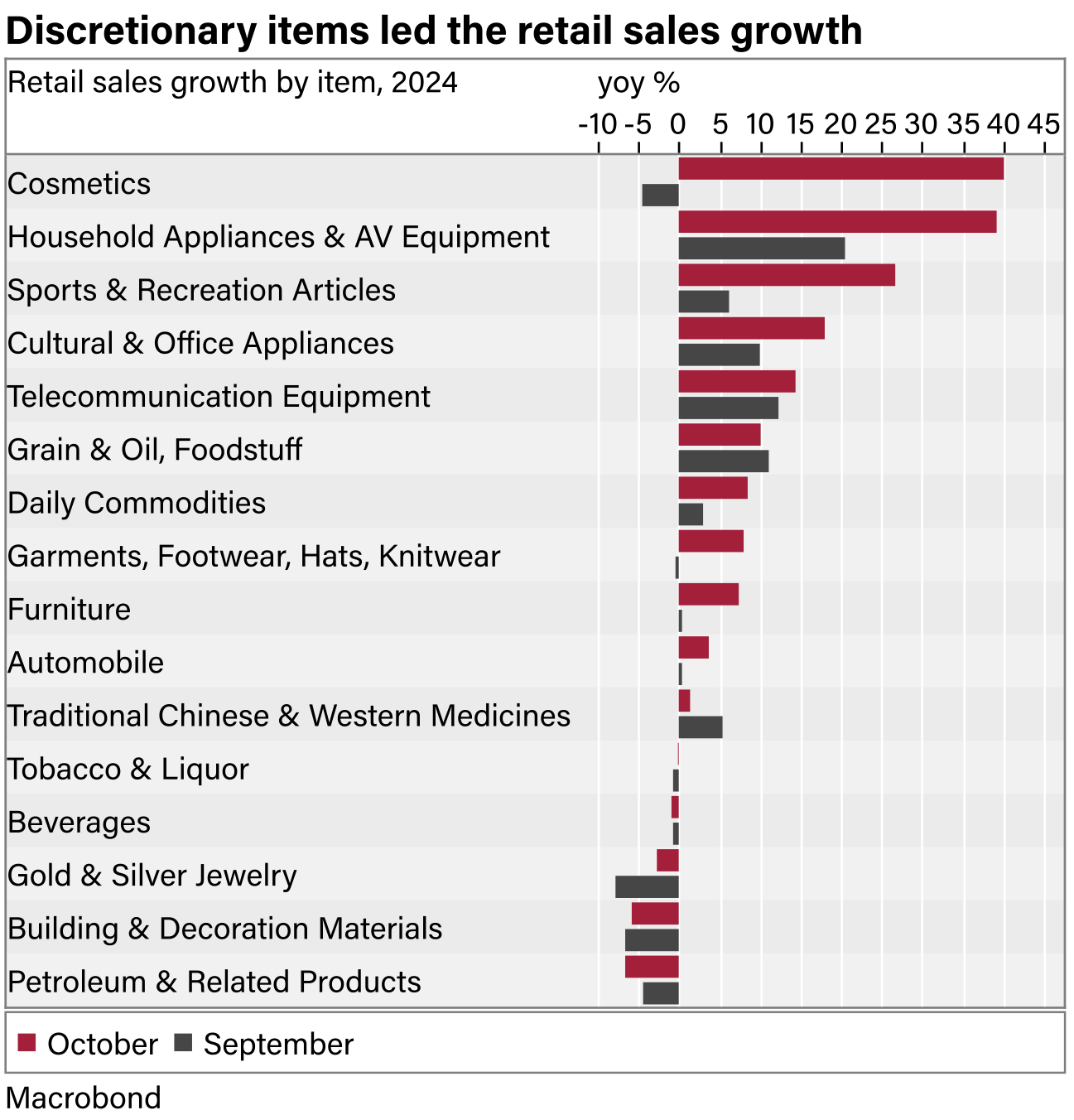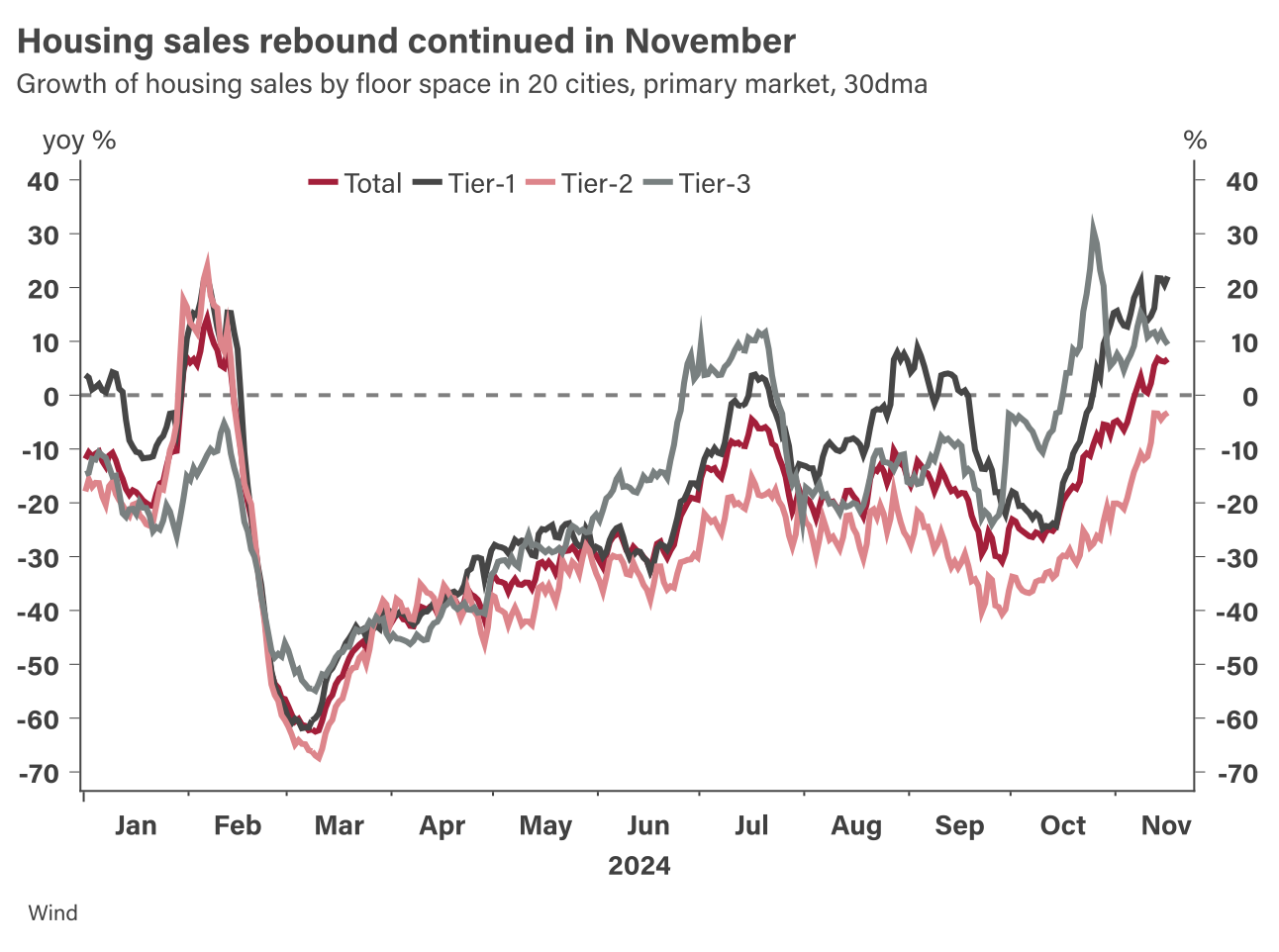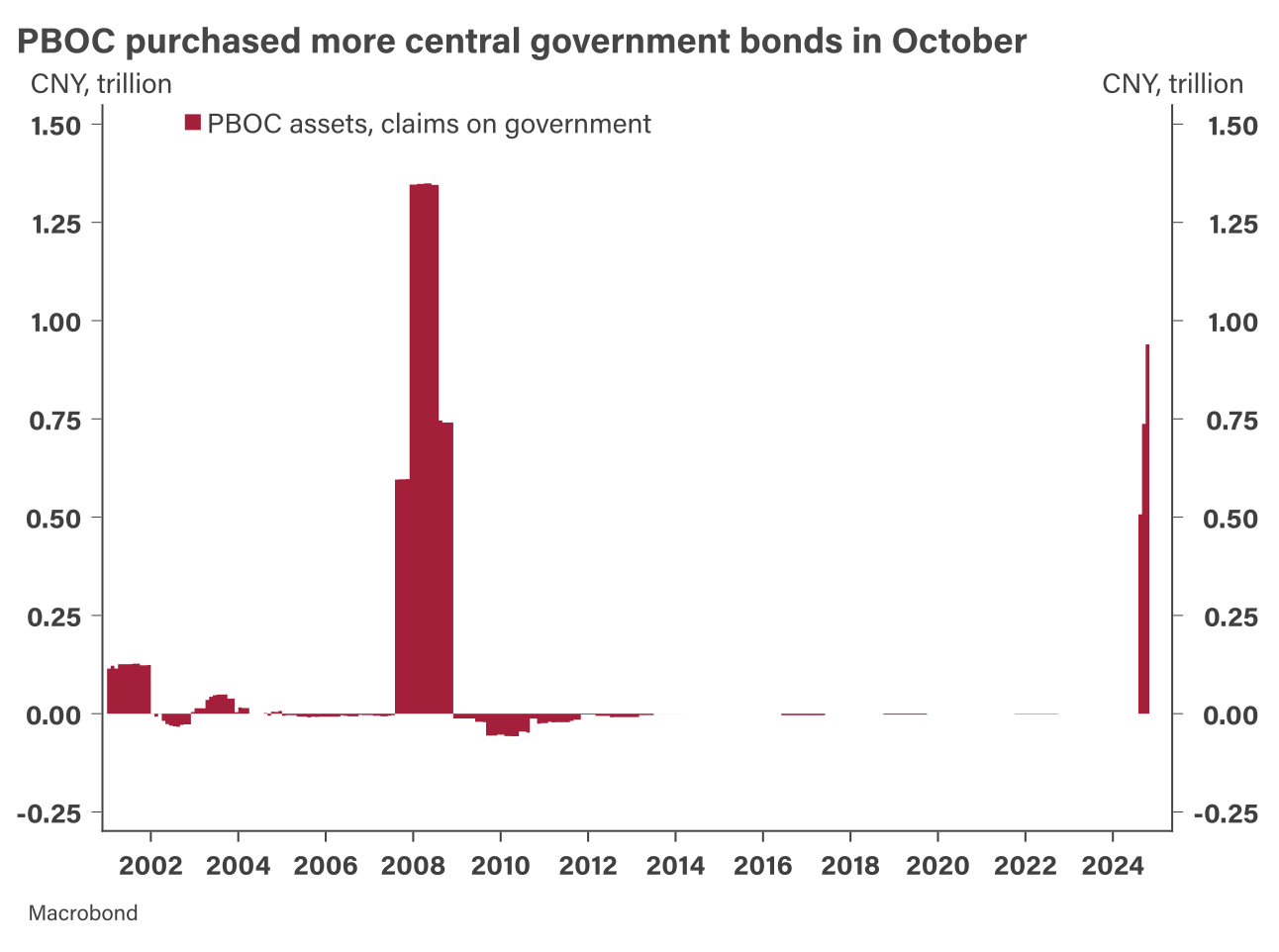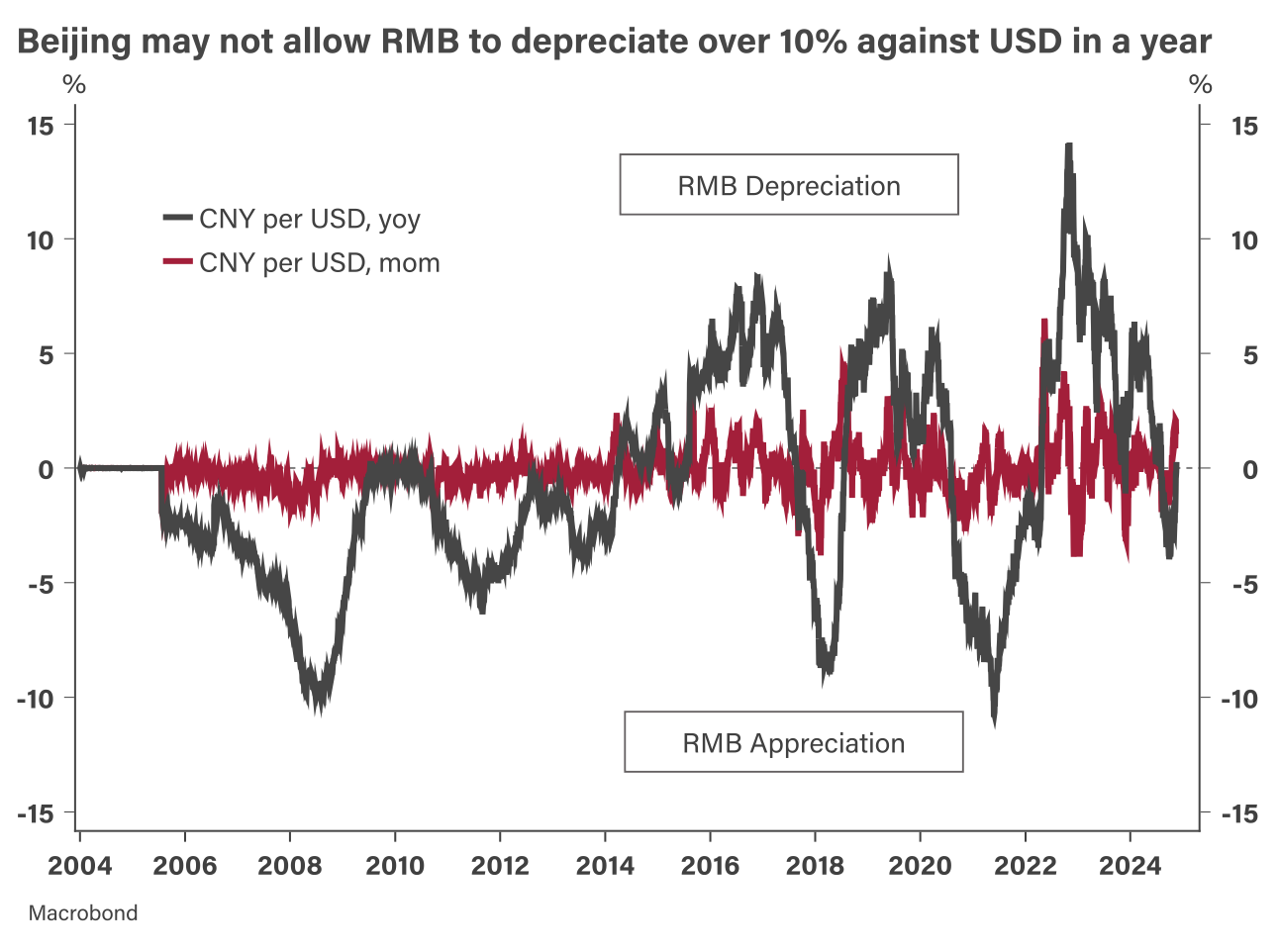China Economy
Q&A: China’s Economy vs US Tariffs
- China’s October economic data revealed improved confidence in both consumption and housing; these areas now appear too strong to warrant immediate fiscal help
- Corporate profits may not recover until next summer
- Beijing’s debt-mitigation plan may be more effective than direct stimulus, by enabling local governments to settle payments to vendors and employees
- By committing to a long-term plan, Beijing is also signaling its intention to keep interest rates low in the next 3-5 years
- Beijing may announce an ambitious growth target next year to boost confidence while reserving some fiscal power for anticipated US tariffs
- A US-China deal is possible—given the two sides’ common interest in trade, investment, technology, security, and currency—but still faces challenges
- Beijing is prepared for a deal to fail, by signaling acknowledgement of and willingness to address trading partners’ concerns
Hutong Research attended dozens of events in Beijing, Shanghai, and Hong Kong in the past week, including the U.S.-China Hong Kong Forum attended by International Department of the Communist Party of China (IDCPC) vice minister Lu Kang and US-China Business Council president Craig Allen. Widely discussed were China’s recent fiscal stimulus and the implications of the US elections, but few could pierce deeply through the lingering fog of uncertainty. Here, we present key observations from these discussions.
Weak confidence?
“Confidence” remains a buzz word. Firms and investors are still concerned about consumer confidence in China, citing its impact on prices and Beijing’s reluctance to enact cash transfers. There are also worries about China’s ability to continue innovating, given tighter IPO rules and Ant Group’s yet-unrealized listing.
Firms are rightfully anxious. We heard across the board that corporate profits collapsed in Q3, even for consumer staples thought to be relatively insulated from economic downturns. According to China’s National Bureau of Statistics (NBS), industrials profit fell by 27% yoy in September, the worst decline since early 2020. For A-share listed nonfinancial firms, profits dropped by 11% yoy in Q3, also one of the worst on record.
Many believe that Beijing’s stimulus is insufficient to boost confidence. Indeed, the fiscal plan approved by the National People’s Congress Standing Committee (NPCSC) fell short of market expectations for direct support to households or the real estate sector. Without that, they argue, consumers will remain reluctant to spend.
These arguments, however, are at odds with China’s economic data for October, released on Friday. Retail sales significantly beat expectations with 4.8% yoy growth, up from 3.2% yoy in September. Discretionary spending on items such as cosmetics, household appliances, and sport products grew dramatically, followed by telecom equipment, food, and clothing. Auto sales growth also accelerated to 3.7% yoy, though gold, liquor, oil, and building materials underperformed.

Housing sales also improved significantly. Based on NBS data, sales of residential properties fell merely 0.5% yoy, versus the 11% yoy decline in September. According to the China Index Academy, China’s top 100 property developers recorded a 11% yoy revenue increase in October—the first yoy growth this year. High-frequency data also revealed strong sales lasting into November with few signs of weakening.

Consumer prices also appear stronger than what the headlines would suggest. China’s consumer price index (CPI) for October did miss expectations, but that was mostly a result of weaker food and energy prices. Excluding those, China’s core CPI actually improved to 0.2% yoy from 0.1% in September.
These data suggest that Beijing’s policies have in fact succeeded in boosting confidence in both consumption and the housing market. Producers, however, may not yet be feeling the impact: Our conversations with executives found that higher sales have mainly enabled retailers to reduce excess inventory, and have not led to more wholesales yet.
Some in the market acknowledged these improvements but questioned their sustainability. For example, they attribute increased sales of household appliances to Beijing’s trade-in campaign, a one-off event. They also cited news of pay cuts and layoffs in many industries and questioned the reliability of NBS data.
We believe that the trade-in campaign will continue next year. As we have repeatedly argued, Beijing’s new policy focus is on promoting consumption, and the trade-in campaign has proved itself the most efficient means of accomplishing this, given the limited fiscal input and its empirical effectiveness. After all, Chinese households do not lack money to spend: They save 30% of their income, or over RMB 10trn a year.
Concerns over household income, however, are valid. With firms suffering from poor profits, it is unrealistic to expect higher wages or more employment. In other words, producer prices must first bottom out before consumer prices can improve more sustainably. This is also why we expect Beijing to continue using policies like the trade-in campaign to boost consumption until a more organic recovery materializes.
For now, we expect producer prices in China to remain weak until next summer, and corporate profits and household income to rebound only thereafter. Some improvement is already underway: In October, China’s producer price index (PPI) fell only by 0.1% mom, narrower than the 0.6% mom decline in September. As the real estate sector stabilizes, so should prices of steel and building materials. The greatest risk lies on oil, however—a major PPI driver. If the US increases oil production under Donald Trump, prices will face significant downside risks.

More stimulus?
Further debate brewed over Beijing’s stimulus. Questions ranged over the effectiveness of existing policies, especially the debt mitigation plan approved by the NPCSC on 8 November and Beijing’s willingness to roll out more stimulus in the future.
Disappointment following the NPCSC meeting is warranted. We had shared hopes of a significant announcement—even if no immediate implementation—to assuage the market in the wake of Trump’s decisive electoral victory. October data, however, seem too positive to warrant additional stimulus, and the market reacted better than had been feared on the following Monday. This all suggests persistent confidence despite the disappointment.
The more closely we examine Beijing’s debt mitigation plan, the more optimistic we are. Firstly, the total package aligns with what the Ministry of Finance (MoF) had pledged in October, despite market speculation of more. Beyond RMB 6trn in additional local-government bond issuances over three years, the package also includes RMB 4trn in special-purpose local government bonds over five years to settle local implicit debt. Further, MoF pledged to cover another RMB 2trn in implicit debt previously incurred from shantytown redevelopment. This amounts to RMB 12trn, larger than the RMB 10trn that had been rumored.
Secondly, the scale of help offered by these debt measures may be underestimated. Instead of the RMB 600bn interest saved, it is the principal that local governments are allowed to raise via bond issuance that matters: With this cash, local governments can finally settle payments to their vendors and employees that have been overdue for a long time.
At the press conference following the NPCSC meeting, MoF noted that China had RMB 14trn in implicit debts at the end of 2023. Earlier in October, MoF noted that China had successfully cut implicit debts by half since 2018. Taken together, this amounts to RMB 14trn in implicit local-government debt settled.
The central government offered little help through those five years. According to MoF, it had only approved RMB 2.2trn in local-government debt-mitigation bonds in 2023 and another RMB 1.2trn more in 2024. The market estimated roughly another RMB 1.5trn in such bonds issued between 2019 to 2022. In total, only RMB 5trn in bonds were made available for local governments to mitigate their RMB 14trn in implicit debt, meaning that RMB 9trn was likely covered out-of-pocket.
This largely accords with the rise in accounts-receivable of China’s industrial firms. NBS data show that these firms held RMB 25trn in accounts-receivable, roughly 20% of the country’s GDP and RMB 7trn more than three years ago. Given the pressure to resolve implicit debt, local governments likely contributed to a significant portion.
In other words, Beijing’s debt-mitigation order likely forced local governments to spend RMB 1.8trn annually over the past five years to resolve implicit debts, contributing to delays in payments to vendors and employees. Allowing the issuance of more bonds to cover debt mitigation thus frees up RMB 1.8trn per year to allocate elsewhere.
Given the size of deposits in Chinese banks, such assistance to indebted local governments rather than universal cash distribution to households is likely a much more effective way of boosting consumption. Cash will be especially critical over the next few months, as rural migrant workers demand payment to bring home for the Chinese New Year.
The market expects local governments to issue RMB 1-2trn in such debt-mitigation bonds over the next two months. The People’s Bank of China (PBOC) has been facilitating this by purchasing more central government bonds (CGBs), thus injecting liquidity and keeping yields low, so as not to crowd out other borrowers.
By committing to debt mitigation over the next 3-5 years, Beijing is also signaling its intent to keep interest rates low in the period. This is now possible with PBOC’s purchase of CGBs and its shift of policy focus from quantity to price in China’s money supply. This all, including a change to China’s fiscal budget-management mechanism in the Third Plenum Resolutions (see: Resolution Articulates Continuity with Incremental Reforms), was greenlit by top leaders. In other words, this amounts to a fundamental change in China’s monetary policy framework, which will last for the next decade.

More MOF-promised stimulus has also been delivered. Last Monday, the Ministry of Natural Resources released a notice allowing local governments to purchase idle land with special-purpose bonds. On Wednesday, the State Administration of Taxation released implementation measures for tax cuts in the real estate sector. Following this pattern, bank capitalization may also happen soon, and December’s Central Economic Work Conference will likely hint at higher fiscal deficit for next year.
In fact, market rumors of a growth target “above 5%” next year are stirring. This would be ambitious, especially given simultaneous rumors of just a 3.5% fiscal deficit. That said, we believe this to be sensible: An ambitious growth target could buoy market confidence, while a conservative fiscal deficit allows room to react to US tariffs. After all, in the last trade war, tariffs only materialized a year after Trump assumed office. And Beijing can always announce new stimulus at the Politburo meetings and adjust fiscal plans at bimonthly NPCSC meetings.
A US-China deal?
Perhaps the most important question is over the possibility of a US-China deal. Another like the one in 2019 would easily boost business and consumer confidence in China and mitigate skepticism over a growth target “above 5%”.
At the US-China forum, speakers from Beijing hinted that China is “wishing for the best but preparing for all possibilities”. Speakers from Washington also expressed support for a deal—but, as they were mostly Democrats, the extent to which this can be generalized to the Republicans soon to control the government is unclear.
“Unpredictability” probably best encapsulates the sum of these discussions. Speakers all acknowledged that the first question is how long Trump’s cabinet nominees will survive, given his track record. While there was consent that a deal is possible given Trump’s transactional approach, no one was able to offer clarity on the exact form of such a deal or the process that could bring it about. The consensus, however, was that things may get worse before they get better.
A deal is possible at least given what Trump is demanding and what Beijing can offer, and vice versa. Allowing Chinese investment in the US could fulfill Trump’s goal to reshore manufacturing, while easing export controls against China could narrow the US’s trade deficit therewith.
Both may face strong resistance in Washington. China hawks in the executive branch like Macro Rubio and Mike Waltz—tapped for the roles of secretary of state and national security adviser, respectively, would surely oppose such a deal. Further opposition may arise in the Senate, given its bipartisan consensus on being tough on China.
The House may be a source of support, given the jobs and tax revenue that such a deal could bring to their districts. This, however, will vary considerably from district to district and based on lobbying power. As well, even though speaker Mike Johnson has signaled support for Trump’s agenda, the Republicans’ narrow margin of control and Congress’s mixed track record may work against that.
Two other suggestions also stood out for their creativeness and significance of stake at play: First is that a deal might go beyond economics. “Trump will want a legacy for decades”, one speaker from Washington suggested, indicating that “he will not like a war in Taiwan, and he may like to see a deal over artificial intelligence (AI)”. Implied is that Beijing may actually rely on Trump to obstruct China hawks from crossing any red lines. As well, AI may be difficult to ignore given Elon Musk’s continuing involvement with Trump.
Second is that a deal may involve currency. Numerous observers have highlighted the mutual inconsistency of Trump’s economic policies. Most notably, tariffs and tax cuts are likely to strengthen the US dollar, though he wants to weaken it. In fact, the only way to weaken a country’s currency is to ask its trading partners to strengthen theirs. China, which has the largest foreign reserves and a government capable of intervening in capital flow, is probably the only one that can manage this. This would also not be the first time, recalling the Plaza Accord in 1985.
Beijing seems aware of this but is denying the possibility of it for now. On 13 November, the Ministry of State Security released an article titled “Financial Security Makes National Security”. According to that, financial security requires that “a country’s financial system be able to withstand internal and external shocks, its financial sovereignty be relatively safe and unthreatened, and its other interests be free from dangers and threats caused by financial means or channels”.
This may change, though, if the US offers substantially more. For example: To reduce US military spending in Asia, instead of asking its allies to pay more, the US could simply reduce its military presence—and especially that around Taiwan. While this may seem an extreme compromise by the US, it does fit with Trump’s goal of focusing on domestic affairs. With such an unpredictable president today, it is probably the time to think the unthinkable.
In any event, Beijing is also preparing for a deal to fail. Last Friday, MoF announced the cancelation of export-tax rebates for aluminum, copper, and certain oil products; and a reduction of those for refined oil, solar, battery, and nonmetallic mineral products. All these have been facing excess capacity in domestically and rising trade barriers abroad. In comparison, Beijing raised export-tax rebates in 2020 to encourage exports and has over the past two years been easing procedures for claiming them.
This clearly demonstrates Beijing’s commitment to addressing concerns raised by its trading partners. In late October, the NPC published an article assessing China’s economic development over the year, acknowledging issue of underpricing in China’s exports, and explicitly pledging to guide exporters raise prices.
We thus believe that Beijing is not interested in cushioning risks from US tariffs with excessive RMB depreciation. The maximum range of depreciation is likely 5% in a month and 10% in a year, as was the case in 2018. In addition to defending the currency using the so-called “counter-cyclical factors”—as PBOC did in the past year—China may now do so by boosting domestic demand. After all, China’s housing market has finally finished its restructuring, and the US Federal Reserve will still enact more rate cuts in the coming year.

In case you missed our recent publications:
© Hutong Research. Redistribution prohibited without prior consent. This report has been prepared for distribution to Hutong Research clients. Information contained herein has been obtained from sources believed to be reliable, but not guaranteed. For more information and research archive, visit: www.hutongresearch.com

